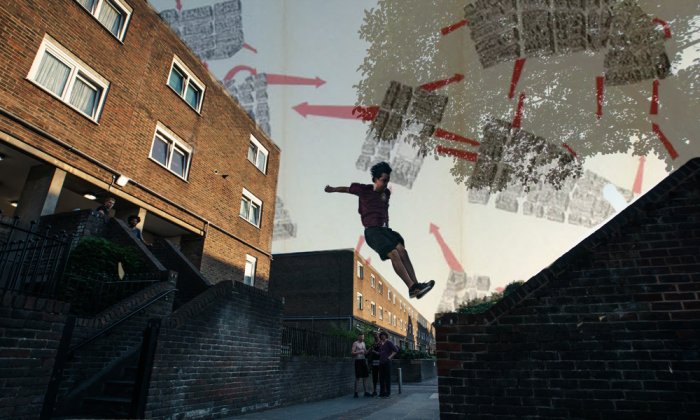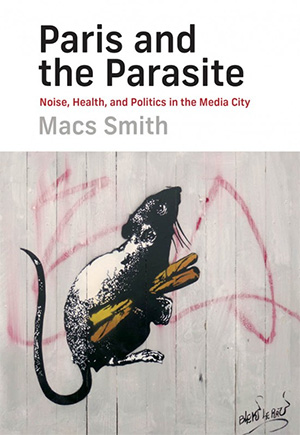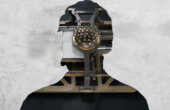Paris Sportif: The Contagious Attraction of Parkour

In 1955, Letterist International, a Paris-based group of avant-garde authors, artists, and urban theorists, published “Proposals for Rationally Improving the City of Paris.” The group, which would become better known as Situationist International, or SI, and play an important role in the May 1968 demonstrations, put forward wild suggestions for breaking the monotony of urban life. Some of these, like the call to abolish museums and distribute their masterpieces to nightclubs, were iconoclastic and anti-institutional, reflecting the group’s anarchic political leanings.
Others were less overtly political and testified to a thirst for excitement. To appeal to “spelunkers” and thrill-seekers, they called for Paris’s rooftops and metro tunnels to be opened up to exploration. The group believed that the mundaneness of urban life in the 1950s was integral to bourgeois capitalism. Boredom was part of how the government maintained order, and so a more equal city would necessarily have to be more frightening, more surprising, more fun.

SI disbanded in 1972, but its ideas about the links between emotion and urban politics have been influential. Among the best examples are the subcultures centered around urban thrill-seeking that exist today, like urban exploration (Urbex), rooftopping, and skywalking, all of which involve breaking into dangerous or forbidden zones of the city. The most famous inheritor to SI’s call to experience urban space differently is parkour, which was invented in the Paris suburb of Lisses in the 1980s. It was inspired by Hébertisme, a method of obstacle course training first introduced to the French Navy in 1910 by Georges Hébert. David Belle learned the principles of Hébertisme from his father, Raymond, who had been exposed to it at a military school in Vietnam. David, along with a friend, Sébastien Foucan, then adapted those principles, originally conceived for natural environments, to the suburban architecture of their surroundings.
Over time, parkour has incorporated techniques from tumbling, gymnastics, and capoeira, resulting in a striking blend of military power and balletic artistry. Parkour involves confronting an urban map with an embodied experience of urban space. It is often defined as moving from points A to B in the most efficient way possible, and parkour practitioners, called traceurs, often depict themselves as trailblazers identifying routes through the city that cartography does not capture. Traceurs sometimes evoke the fantasy of tracing a straight line on the map and finding a way to turn it into a path, although in practice, they more often work at a single point on the map — a park, a rooftop, an esplanade — and end a session back where they started.
Boredom was part of how the government maintained order, and so a more equal city would necessarily have to be more frightening, more surprising, more fun.
Traceurs’ desire to rewrite the map is another thing they share with the Situationists, who liked to cut up maps and glue them back together to show the psychological distance between neighborhoods. But parkour distinguishes itself from SI through its use of video, which continues to be a point of debate within the practice. In the early 2000s, Sébastien Foucan reignited this debate when he broke away from Belle to pioneer his own version of the training system.
Foucan’s appearance in the 2003 documentary “Jump London” cemented “freerunning” as the name for this alternate practice, which put a greater emphasis on stylized movements. Foucan would go on to play a terrorist bomb-maker in Martin Campbell’s “Casino Royale,” leaping from cranes with Daniel Craig’s James Bond in pursuit. Some parkour purists see this as a degradation of the utilitarian roots of their training, and insist instead on a physio-spiritual discourse of communion with the environment, mastery of fear, and humility. They reject freerunning as a brash corruption of Hébert’s principles. The sociologist Jeffrey Kidder notes in his interviews with traceurs in Chicago that they dismiss participants who lack interest in serious rituals like safety, humility, and personal growth. They react negatively to media coverage that highlights parkour’s danger or assimilates it into adolescent rebellions like skateboarding, drug use, or loitering.
In my own email interview with the leaders of Parkour Paris, the official parkour organization of Paris, the same will to blame media is evident: “Parkour has been mediatized in ‘connotated’ films. The traceurs depicted in those fictions were friendly delinquents a bit like Robin Hood. Friendly, yes, but for the immense majority of people they were still delinquents from the banlieue,” they gripe. “It’s been very hard to shake that image.”
However, in Kidder’s studies of Chicago traceurs, there are just as many participants there to make videos as there are to tell them that’s not what parkour is about. Parkour Paris may feel that films have given people the wrong ideas about parkour, but the films they are alluding to include several starring David Belle, the figure who, in the schism with Foucan, supposedly represents traditional parkour. Parkour Paris has posted dozens of videos of their members performing tightly choreographed, dangerous parkour runs on YouTube. Ultimately, if some traceurs bristle at their practice’s association with certain films or videos, and feel they have to police their colleagues’ practice, that is because of the close association between parkour and video in the minds of the broader public. Visual media — digital media in particular — are integral to parkour’s identity, and the distinction purists make between parkour and its supposed corruptions is more prescriptive than descriptive.
Traceurs engage with digital media in two primary ways. First, they use digital maps to organize parkour sessions. Second, they create digital videos that are shared on online platforms like YouTube, Facebook, and Instagram. These videos collectively constitute parkour as a meme. The communications scholar Limor Shifman defines memes with reference to viral media. The latter are individual texts that reach a large audience through word-of-mouth sharing. A meme, by contrast, is not a single text. It is a framework upon which users improvise and iterate, resulting in a large number of distinct texts that are nevertheless recognizable as part of a single discursive field. Whereas the viral moves its viewer to share it, the meme invites the viewer first to rewrite it and then to share it. Most memes are still images, but, as in the case of parkour, they can take the form of videos. Video memes like parkour present viewers with a framework into which they can inscribe their bodies to produce a new iteration.
In her book “Memes in Digital Culture,” Shifman describes the meme and the viral as two poles: a video or an image can start as a meme and a single iteration of it can go viral, or a viral text might inspire a meme. There are some parkour videos that come closer to Shifman’s definition of the viral — high-quality productions with millions of views characterized by celebrity participation (Belle or Foucan) or brand partnerships (French Freerun Family’s advertisement for the “Assassin’s Creed” video game franchise, for example) — while others are more memetic. For Shifman, more memetic means more incomplete. While a viral text stands alone, a meme is somehow not self-sufficient. It adds something to a discourse while simultaneously opening a gap that demands to be filled by more texts.
In parkour, incompleteness can take the form of a move that is not executed properly, production values that are too low, or a feeling that a given traceur is not transgressive or dangerous enough. Many of the most popular parkour videos are of “parkour fails”: compilations of failed stunts. The popularity of such videos is a kind of mise en abîme of the fact that every contribution to a meme is deficient. To put it another way: On some level, all parkour is a parkour fail. The inexorably unsatisfying videos push viewers to respond by supplementing the lack with more videos of their own. Memes are also fueled by the social and economic incentive of likes, views, and shares, which bring status within the ephemeral community of the meme. This further incentivizes upping the stakes of existing videos by playing in spaces — the Eiffel Tower, for instance, or Chernobyl, as one group did — that are more restricted, more dangerous, and more spectacular.
Parkour and the Parasite
The parasite gets power less because he occupies the center than because he fills the environment.
—Michel Serres
Parkour is viral in another sense, too. In “The Parasite,” the French philosopher Michel Serres discusses parasites from every angle. He writes about biological parasites that cause disease, social and economic parasites that benefit from other people’s labor, and mediatic parasites, noting that many European languages including French use the word “parasites” for interference on a television or radio. Serres observes that people have a reflexive tendency to try to eliminate parasites from a system, and he explores what is at stake in that reflex.
Serres’s discussion of parasites in communication is one of the most stimulating areas of his thought. He is critical of what he sees as the dominant thinking about communication, in which a speaker and a listener are connected by a medium, the former puts a message into the medium where it encounters some noise, and the listener then decodes the message by separating the meaning from the noise. In Serres’s view, noise (parasites) can’t simply be picked out of a message the way one would pick onions off a sandwich. Noise is intrinsic to communication, and there’s no meaning without it. He is also suspicious of the autonomy of the subject, preferring to see people as bound up in networks they don’t have perfect control over.
A video that calls itself parkour is parkour, regardless of how poorly it corresponds to other iterations on the meme.
To illustrate his model of communication, he imagines soccer players in a rondo, passing a ball around. A bad player of this game, he says, is one who brings the ball to a complete stop so they can decide where it should go next. A player like that is too fixated on their own autonomy, on bending the game to their will. An even worse player doesn’t pass it at all, fearing they’ll never get it back. A good player adapts to the ball, using its momentum to send it on its way. They bring their own flair to the pass, but they are happy to give up some autonomy to enable other players to get involved.
Serres calls the ball in this game a “quasi-object.” It is an object because it’s acted upon by the players, but it’s not just an object because, like the conch in William Golding’s “The Lord of the Flies,” it determines who the subject is.
I see memes as manifestations of Serres’s parasitic passing game. In the case of parkour, the quasi-object is the digital video platform. A player takes possession of it by producing a video and uploading it with the right tags and title for it to reach other traceurs. Anyone can add a video with almost any content to the network — it does not have to meet any established idea of what parkour is. A search for “parkour” thus returns pastiches of parkour videos, misunderstandings of parkour, the aforementioned parkour fails, and total non sequiturs. As shown by the purists described above, there can be a strong urge by one player to police how other participants play the quasi-object, but the structure of Serres’s game is such that no single player determines how or by whom the quasi-object is played. A video that calls itself parkour is parkour, regardless of how poorly it corresponds to other iterations on the meme.
This fundamental openness to “bad” play was parodied in an episode of the American version of the sitcom “The Office” in which characters who have watched a parkour video tumble their way through the office, knocking things down as they go. They yell out “parkour” again and again. With these exclamations they tag their practice and inscribe it in the discursive space of the meme. As Jim Halpert says, that is all it takes for a text to be part of a meme: “The goal is to get from point A to point B as creatively as possible, so technically they are doing parkour as long as point A is delusion and point B is the hospital.”
One of the key features of Serres’s parasitic game is that players have to give up some agency to take part. They’re encouraged to defer to the ball, becoming relays along its path rather than masters of it. Fears about the loss of agency are present in the way people talk about memes and viral media as well. The word “meme” was coined by Richard Dawkins in “The Selfish Gene.” Dawkins proposes a Darwinian explanation for the spread of culture, and offers the meme as a hypothetical analogue to the gene. Just as the gene is the basic informational unit of biology, the meme would be the informational unit of culture, the building block out of which concepts are built.
The central argument of “The Selfish Gene” is that natural selection does not act on organisms, but on genes. Dawkins anthropomorphizes genes, ascribing selfishness to them. This rhetoric implies a displacement of agency from the organism to genes. Organisms are vehicles, Dawkins says; genes are the drivers. An organism is sometimes discarded, sometimes allowed to die, if it is in the interests of the gene. The same principles apply to Dawkins’s hypothesized memes. These units of information spread through minds, replicating themselves as best they can. The human is not the agent of culture. The mind is the host or ecosystem in which units of culture battle for supremacy.
Dawkins uses “viral” in this context for parasitic memes that do not act in the best interests of the minds they inhabit. Viral media are true parasites in the biological sense, exogenous pathogens that take up malignant residence in a host organism. Dawkins’s theory of memes has little currency in biological circles, and his definitions of meme and viral do not correspond to how the terms are used online today, but his notions of selfish memes, conceptual parasites, and of the mind as host rather than agent of culture remain relevant. They tie into ongoing anxieties about agency and digital culture, anxieties that are often expressed using the language of disease.
Parkour is a particularly fruitful area in which to examine these dimensions of the meme, because it directly implicates the bodily health of the participant. Traceurs are exposed to real physical danger when they hang off the sides of buildings and leap onto concrete structures. Dawkins discusses the extreme case of an organism that is allowed to die so that its genes can better spread; in parkour, there is a real chance of the organism dying in the interests of the meme. This direct threat to the body actualizes the contagious rhetoric around memes. Doctors have warned parents against the dangers of letting their children be exposed to parkour videos online. Dr. Kenneth Frumkin, in a letter to Annals of Emergency Medicine, uses an invasive vocabulary to describe parkour: “this activity started in France and remains largely outside the United States,” he writes, but risks becoming “(very) dangerously cool” if the medical profession does not intervene.
Dawkins discusses the extreme case of an organism that is allowed to die so that its genes can better spread; in parkour, there is a real chance of the organism dying in the interests of the meme.
In his interviews with traceurs, Kidder finds that many of them took up the practice because of this kind of exposure. He quotes one whose explanation is emblematic of the idea that participation in the meme is reflexive rather than conscious: “I watched it online, and I was like, ‘Cool, I’ll do it.’” Some parkour clubs have responded to the fear of their practice’s contagious spread with pseudo-medical warnings à la cigarette packaging on their websites, and Parkour Paris includes footage of failed stunts in their videos as a way of underscoring the danger.
Fears of contagion are ubiquitous in representations of parkour as well. Many video games that reference parkour, or in which the player character’s movement through the world is inspired by parkour, tie the player’s parkour abilities to some kind of bodily infection. In “infamous,” the protagonist, who can do parkour, is trapped in a dystopian city by a viral outbreak. The protagonists of the “Assassin’s Creed” games get their parkour abilities by plugging into a computer program, but doing so leads to brain disease. The main character of the zombie game “Dying Light” is an undercover soldier sent into a blockaded city to recover a stolen file. His parkour abilities, the player is told, give him superiority over the undead who cannot climb. In the game’s opening sequence, however, the player is bitten, and over the course of the game he slowly succumbs to the virus. He becomes the disease parkour was supposed to exempt him from. In an alternate mode, the player can reverse roles, playing as a zombie instead of a survivor. The traceur is coded as a contagious figure who, though liberated by his athletic abilities, represents an ongoing threat of infection to the wider network.
Parkour, in sum, is intersected by a variety of biological, infectious discourses. It encourages players to adopt a relational mode of subjectivity based on the circulation of a quasi-object — what Serres calls the parasitic collective. This parasitic way of relating to mediation turns parkour practice into a meme, itself a genetic metaphor for the transmission of ideas which implies that culture is a form of parasitism. New players are drawn in by viral texts, and alter their relationship to the city in response. The definition of parkour that emerges is a noisy one, riddled with internal contradictions engendered by the free circulation of the quasi-object. Parkour is frequently represented, by both artists and doctors, as an epidemic threat to the social body and to the city. These medical discourses are not entirely hollow, either, because people have died from parkour. People jump off buildings to get views on YouTube.
Thinking back to Letterist International with all of this in mind, parkour seems to have answered the group’s call for a revolution in the urban emotional landscape, and it seems to have done so by encouraging people to embrace parasitism. In my book “Paris and the Parasite,” I argue that the past two centuries of Parisian urbanism have been governed by the impulse to eliminate parasites from the city, and I examine cases of people appropriating the title of parasite in a positive way as part of a challenge to the urban order. Parkour, with its infectious call to defy the norms of the city, is in many ways a perfect example of the latter.
However, one of Serres’s recurring points is that nothing is a parasite permanently. Parasitism is always relative, always contextual. Parkour may have been born on the margins, in the suburbs of the city, but nothing guarantees it will stay there. Indeed, Paris recently opened a padded, indoor parkour gym in the redesigned Les Halles shopping center, in the old “belly” of the city. That shift symbolizes the growing “sportification” of parkour, a movement away from transgressive thrill-seeking and towards the regimented promotion of health and physical fitness — a change with problematic undertones if one remembers that Hébertisme, the exercise philosophy that inspired parkour, was a pillar of Vichy France’s eugenic national health program.
In a city where hygiene, safety, calm, and order have long gone hand-in-hand, there is something revolutionary in parkour’s promise of an epidemic of high-energy misbehavior. What comes of that revolutionary potential depends in part on whether traceurs insist on the parasitic, authority-challenging qualities of their practice, or whether they allow it to become just another thing you can do at the gym.
Macs Smith is Career Development Fellow in French at the Queen’s College at the University of Oxford and the author of “Paris and the Parasite,” from which this article is adapted.



